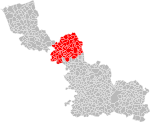The siege of Lille (12 August – 10 December 1708) was the salient operation of the 1708 campaign season during the War of the Spanish Succession. After an obstinate defence of 120 days, the French garrison surrendered the city and citadel of Lille, commanded by Marshal Boufflers, to the forces of the Duke of Marlborough and Prince Eugene.
The siege was famous among contemporaries for l'affaire des poudres ("the gunpowder incident"), where the Chevalier de Luxembourg with 2,000 horsemen passed through the Allied lines and succeeded in delivering 40,000 pounds of desperately needed gunpowder to the defenders.
The siege was made possible by the defeat of the French army at the Battle of Oudenarde and the landing in Ostend of large amounts of ammunition and food after the Battle of Wijnendale. Initially, the allies were divided over which cities should be targeted following the battle of Oudenaarde. Bernaldo de Quirós, a Spanish nobleman who had sided with the Allies after the battle of Ramillies, proposed the siege of Mons and Charleroi to secure Brabant and clear the way to France. Instead, under pressure from the English government, Marlborough insisted on capturing Ypres. However, Eugene and the Dutch deputies favoured an attack on Lille. Eugene argued that the capture of this city was crucial for a successful invasion of France. In addition to this, the Dutch deputies had other good reasons for their preference for Lille. After its conquest by the French in 1667, Lille had become one of the most important French cities and the wealthy city paid a large part of the French war chest. In addition, much of the booty captured by the Dunkirk Privateers from the allied merchant fleets ended up in Lille. A capture of this city would be a major blow to the French king.
For most of the campaign, Eugene commanded the forces besieging Lille, while Marlborough commanded the forces covering those forces against external French interference. For a short period in late September however, after Eugene was injured on the 21st, Marlborough took command of both the besiegers and the covering force.
On 22 October the Allies entered the city at the staggering cost of 12,000 casualties; Boufflers continued to resist from Lille's citadel for several weeks, exacting an additional 4,000 allied casualties. While the allies' deft manoeuvring frustrated French attempts to relieve the strategically important fortress—the last substantial French bastion in northern Flanders—Boufflers' valiant defence likewise prolonged the siege well into winter, to the point where no operations could be undertaken against France that year. The French garrison of Lille capitulated on 10 December and the remaining defenders marched out with full honours of war, and Boufflers was decorated by Louis XIV.
For France, the results of the siege were mixed. The city's stubborn defence tied down Marlborough for the remainder of the 1708 campaigning season, preventing him from inflicting further damage on France in the aftermath of Oudenarde. But, with the loss of Lille, northern Flanders reverted to allied control; the Allies moved against Ghent, taking the city in late December. The fall of Lille also opened a corridor for an allied invasion of France in 1709, although this effort would be slowed down by the bloody battle of Malplaquet.











